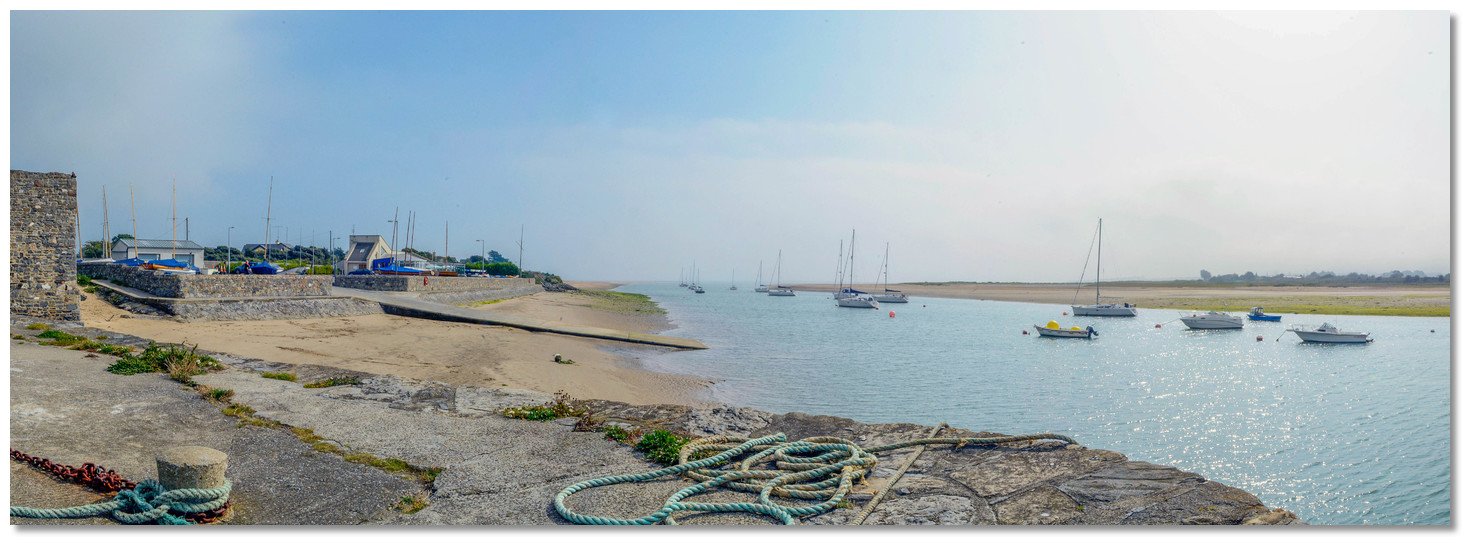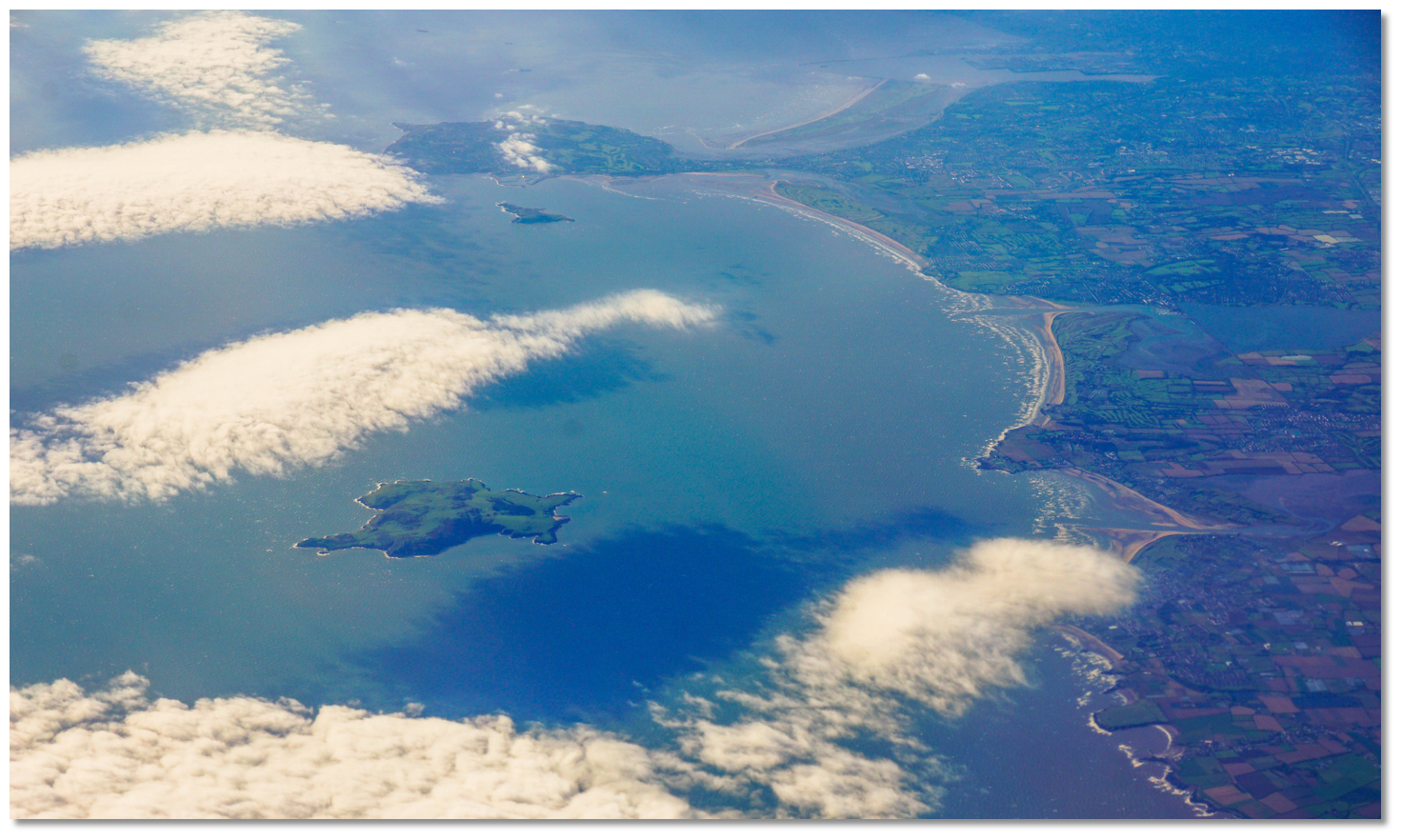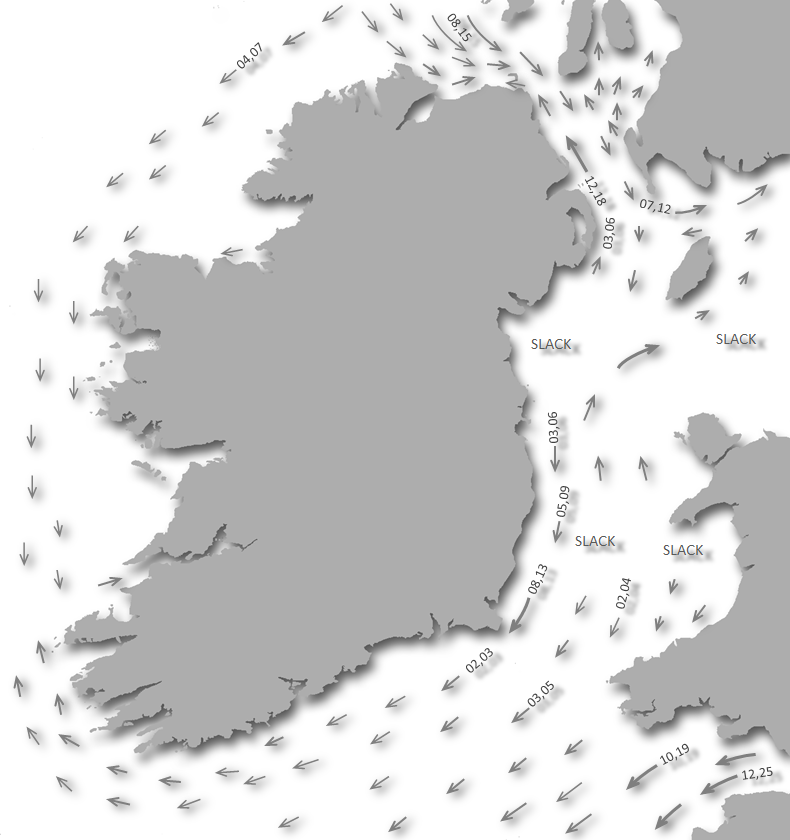
Set within a narrow, enclosed waterway, with a sandbar protecting its eastward approach path, the inlet provides good protection. Attentive navigation is required for access during daylight as the access channel, although furnished with unlit marks, it is narrow and subject to strong currents and it may only be approached near high water to have sufficient water to pass over the sandbar.
Keyfacts for Rogerstown Inlet
Facilities








Nature







Considerations




Protected sectors
Approaches


Shelter


Last modified
November 17th 2020 Summary* Restrictions apply
A good location with attentive navigation required for access.Facilities








Nature







Considerations




Position and approaches
Expand to new tab or fullscreen
Haven position
 53° 30.615' N, 006° 7.163' W
53° 30.615' N, 006° 7.163' WThis is the position of the Rush Sailing Club moorings.
What is the initial fix?
The following Rogerstown Inlet initial fix will set up a final approach:
 53° 30.104' N, 006° 5.424' W
53° 30.104' N, 006° 5.424' W What are the key points of the approach?
Offshore details are available in eastern Ireland’s Coastal Overview for Strangford Lough to Dublin Bay  .
.
 .
.- Berthing can only be achieved via prior arrangement and the accommodation of the Rush Sailing Club.
- Find the safe water marker situated on a line between the Martello Towers on the headlands.
- From its position look to the west to find the first of the channel marks and align to pass in between the port and starboard unlit buoys on a bearing of 300° Magnetic.
- Proceed up the channel following the pairs of buoys in.
Not what you need?
Click the 'Next' and 'Previous' buttons to progress through neighbouring havens in a coastal 'clockwise' or 'anti-clockwise' sequence. Below are the ten nearest havens to Rogerstown Inlet for your convenience.
Ten nearest havens by straight line charted distance and bearing:
- Rush Harbour - 1.6 nautical miles ENE
- Loughshinny - 2.6 nautical miles NNE
- The Boat Harbour - 3.2 nautical miles ESE
- Talbot’s Bay - 3.4 nautical miles ESE
- Malahide - 3.6 nautical miles SSW
- Saltpan Bay - 3.6 nautical miles ESE
- Seal Hole Bay - 4.2 nautical miles ESE
- Skerries Bay and Harbour - 4.5 nautical miles N
- Balbriggan Harbour - 6.5 nautical miles NNW
- Carrigeen Bay - 6.6 nautical miles SSE
These havens are ordered by straight line charted distance and bearing, and can be reordered by compass direction or coastal sequence:
- Rush Harbour - 1.6 miles ENE
- Loughshinny - 2.6 miles NNE
- The Boat Harbour - 3.2 miles ESE
- Talbot’s Bay - 3.4 miles ESE
- Malahide - 3.6 miles SSW
- Saltpan Bay - 3.6 miles ESE
- Seal Hole Bay - 4.2 miles ESE
- Skerries Bay and Harbour - 4.5 miles N
- Balbriggan Harbour - 6.5 miles NNW
- Carrigeen Bay - 6.6 miles SSE
Chart
What's the story here?
 Rogerstone Inlet, top, with Malahide Inlet, bottom
Rogerstone Inlet, top, with Malahide Inlet, bottom Image: Tearbringer via CC BY-SA 4.0
Rogerstown is a small coastal estuary nearly midway between the Skerries and Howth that is entered about 3 miles west by northwest of Lambay Island. The inlet indents the coastline by about two miles leading into a narrow creek. This is fronted by a bar that dries at LAT to 0.2 metres over a small portion. Within this is a narrow channel that leads between its drying sands to a stone pier and slipway on the north shore overlooked by the clubhouse of the Rush Sailing Club.
Sheltered from the sea by its broad sand and shingle spit the small tidal embayment affords a well-sheltered anchorage for craft of no more than medium draft. A reasonable draft expectation on the bar, at HW ±2.5, is a depth of 1.5 metres. It can become very lumpy in southeast winds and an ebb tide at the bar so allowances must be made. Rush Sailing Club maintains seasonal marks along this channel between April and October.
 Private boat moorings in the channel
Private boat moorings in the channelImage: Michael Harpur
Moorings have to be used in the Rogerstown Inlet. Anchoring is not practical due to the density of local boat moorings in the channel and strong tidal streams that attaining speeds of up to 5kts at the mouth of the inlet during springs. There are about twenty privately owned local cruiser moorings that support drafts of up to 1.5 metres at low water. These are located in the mouth of the estuary near the clubhouse.
 The view eastward from the head of the pier
The view eastward from the head of the pierImage: Jonathan Mason
The club itself has no moorings as all the moorings in the inlet are individually held. However, almost all are held by club members and club facilitates the use of unoccupied moorings. Rush Sailing Club
 can be contacted on
can be contacted on  +353 (0)1 843 0695,
+353 (0)1 843 0695,  RushSClub@Gmail.com. The club telephone number is only useful when the club is open.
RushSClub@Gmail.com. The club telephone number is only useful when the club is open.  Clubhouse of Rush Sailing Club
Clubhouse of Rush Sailing ClubImage: Michael Harpur
Visitors wishing to make arrangements will find contact numbers for Club Officers on the club website
 . Consideration is being given to arranging a few visitor moorings in the inlet.
. Consideration is being given to arranging a few visitor moorings in the inlet. 
How to get in?
 Lambay Island almost in front of the Rogerstown Inlet
Lambay Island almost in front of the Rogerstown InletImage: Bill Boaden via CC BY_SA 2.0
 Ireland’s Coastal Overview from Strangford Lough to Dublin Bay
Ireland’s Coastal Overview from Strangford Lough to Dublin Bay  provide approach details. Positioned almost opposite Lambay Island, the directions provided for Lambay's west facing Boat Harbour
provide approach details. Positioned almost opposite Lambay Island, the directions provided for Lambay's west facing Boat Harbour  provides details for the body of water between.
provides details for the body of water between. The extremities of the coastal indent has on its northern end a rocky point with a Martello Tower standing on its extremity. The town of Rush, with its beach, is situated to the north of this. The head of the bay’s southern arm, situated 1¾ to the southwest, is Portrane Point that is made as conspicuous by a corresponding Martello tower and several other towers close inshore. The estuary is enclosed by a sand dune bar, called 'The Burrow', that is fronted by Portrane Beach. The sandbar terminates at the mouth of the estuary situated close to the north shore.
Vessels approaching the initial fix should keep the whole of Howth Peninsula, located seven miles to the south, open to the east of Portrane Point to stay in deep water. If passing Portrane Point standoff at least 500 metres to avoid its rocky outcrops that include the visible Cable Rock.
 Rogerstown Safe Water Marker with the channel and club in the backdrop
Rogerstown Safe Water Marker with the channel and club in the backdropImage: Jonathan Mason
 From the initial fix the red and white stripped Rogerstown Inlet Safe Water Mark should be readily apparent. Expect this to be located to the south of the midway point of a line between the Martello Towers of Portrane and Rush Points.
From the initial fix the red and white stripped Rogerstown Inlet Safe Water Mark should be readily apparent. Expect this to be located to the south of the midway point of a line between the Martello Towers of Portrane and Rush Points.  Closely spaced club channel buoys marking the channel
Closely spaced club channel buoys marking the channelImage: Jonathan Mason
The first pair of marks for the channel should be about 900 metres north-westward from the Safe Water Mark and readily apparent. A useful entry alignment is to set off to approach the marks from the southeast or more precisely head towards the marks on a bearing of 304°M magnetic (299° T) keeping the southwest end of Lambay Island inline astern. This clears a spit that dries at low water and extends well east of the marks on the north side of the approach.
 View westward from the northern edge of the spit at low water
View westward from the northern edge of the spit at low waterImage: Jonathan Mason
Once in the channel, it is simply a matter of following the pairs of red and green, port and starboard markers, all unlit, on a bearing of about 300°T for ¾ of a mile into the club and pier on the north shore. The channel will be found to be deepest close to the sand spit at its northern margin, but the tolerance is fine so care should be taken not to stray north of the starboard hand marks.
 The commencement of the mooring area in the channel
The commencement of the mooring area in the channelImage: Michael Harpur
Expect the least depth for the passage to be further up the channel as opposed to the on the bar, though the bar depth is obviously more critical in a lumpy sea. This constantly shifts but as an indicator, a depth of 2.1 metres was at the bar and a least depth in the channel of 1.4 metres at the time of writing. Those operating on the margins are advised to check with Rush Sailing Club well in advance of an approach.
 The mooring area as seen from the head of the pier
The mooring area as seen from the head of the pierImage: Jonathan Mason
 Once in the moorings area pick up the designated moorings as directed by the club in advance. The deepest draft on the moorings is 1.5 metres and some in the channel are less at 1.2 / 1.3 metres. There are one or two spots with close to 2 metres, but cannot to be relied upon to be available.
Once in the moorings area pick up the designated moorings as directed by the club in advance. The deepest draft on the moorings is 1.5 metres and some in the channel are less at 1.2 / 1.3 metres. There are one or two spots with close to 2 metres, but cannot to be relied upon to be available.  Club slipway by the mooring area
Club slipway by the mooring areaImage: Michael Harpur
Land by tender at the slip. The club has no punt service ferrying to-and-fro to the moorings, so visitors will require their dinghies to make a landing. Outside of slack water, the use of an engine is essential for the moorings east of the pier.
The old stone pier running north-south to the west of the sailing club was formerly used for landing coal and is now owned by the Lambay Estate and serves as the access point to Lambay Island. It is not generally available to yachts, though boats that can take to the hard can use the muddy drying section on the west side of the pier, bounded to the west by the Sailing Club’s boat park. Those coming alongside should come in close to the pier as a high sandbank has built up close west of the pier as can be seen below. Normal precautions should be taken if lying alongside this open publicly accessible pier.
 Shallow draft moorings above the pier
Shallow draft moorings above the pierImage: Jonathan Mason
The inlet quickly shallows 150 metres westward of the pier. Here the estuary opens out to its large area of drying sand, mud and shallow water, where moorings for shoal draft boats will be seen.
Beyond this, the Rogerstown Estuary that encloses a large expanse of water opens up. It is made up of saltwater marshes, wet meadows, shallows and creeks, the vast majority of which dry to sand or mudflats at low water. This is divided into inner and outer portions by a viaduct carrying the Dublin/Belfast railway line. The mudflats and salt marshes are an important sanctuary for wintering birdlife and designated a Special Protection Area (SPA) for birds.
Why visit here?
Rogerstown Estuary, directly translating in Irish to Inbhear Bhaile Roiséir, is an ancient seaport. The very English sounding name of Rogerstown, is surprisingly very old, older even than the Norman Conquest. It is and anglicisation of Rogershaven that was given to it by the Norsemen who landed here and made it their base. The north shore of the Rogerstown Estuary at low water
The north shore of the Rogerstown Estuary at low water Image: Michael Harpur
When it was called Rogershaven it was then a more important place than it is now. Fragments of mediaeval pottery have been found on the shore and it is likely that there was once an inn here. The estuary then was navigated to the port of Lusk, long since gone. Local legend has it that there was once a bridge across the mouth but it had to be removed as a result of various suicides. Some remains of what is said to be this bridge still exist today on the Donabate beach. Another ancient seagoing yarn, however, seems to be based on much more reliable evidence. This is a curious tale dates back to early Anglo-Norman times when the sanctuary found in the estuary brought about the construction of the ancient Celtic chapel in Kenure Park.
 Rogerstown as seen from westward of the clubhouse
Rogerstown as seen from westward of the clubhouseImage: Mark Murray via CC BY-SA 2.0
Legend has it that the original church on the site goes back to French navigators who were caught out in a furious storm. The boatmen, believed to have been Crusaders, were bound for England but were driven off by the force of weather. In danger of perishing, they made a vow to the patron saint of sailors St Maur, who was greatly venerated in France, that if they ever survived the storm-tossed seas, they would build a chapel in his honour on the point of land they first touched. They subsequently landed at Rogerstown and built a wooden chapel on the high ground above the inlet as vowed.
 Rush Sailing Club launching Mermaids from the slipway
Rush Sailing Club launching Mermaids from the slipwayImage: Jonathan Mason
This was at Kenure about a mile west of the centre of Rush, and the current ivy-covered ruin was established later on the grounds of the church. The area became known as Knightstown and later Whitestown. In 1776, a church was built closer to the centre of Rush to replace the old chapel. It is one of the earliest examples of a penal Catholic church in the Fingal area and is also dedicated to St Maur.
 Rush Sailing Club launching Mermaids
Rush Sailing Club launching MermaidsImage: Jonathan Mason
The limestone pier was built about at the turn of 19th century and is made up off random coursed walls with dressed stone kerbing to edge. The pier not only served the fishing industry but coal boats unloaded here up to the 1940s. The remains of the coal yard to the east are a reminder of what would once have been a hive of activity. At the turn of the 20th-century the estuary was used by British forces for battle training their troops and horses. The horses were trained at Reamount which is in the village of Lusk about 5km from Rush and the farm at Reamount also served as a prison back in the 1800s. Since their departure, it has been left to become an enchanting backwater that has become an important link in the chain of estuaries on the east coast. It is today a statutory Nature Reserve and a candidate for a Special Area of Conservation.
 Close racing competition between the inlet and Lambay
Close racing competition between the inlet and LambayImage: Jonathan Mason
The estuary is made up of saltwater marshes, raised salt marsh, wet meadows and riverine shallows and creeks. It covers an area of 3.63 km2, or 900 acres, and is divided by a causeway and bridge built in the 1840s to carry the main Dublin–Belfast railway line. The estuary's mouth separates the two of Fingal’s beautiful beach fronted areas; Donabate and Rush. The mouth of the estuary is so narrow, it is suggested that a person could stroll from Rush to Donabate within a minute if there was no water.
 Competing off Lambay Island
Competing off Lambay IslandImage: Jonathan Mason
Today the Rogerstown Estuary supports a huge store of wildlife. It is internationally recognised as one of the most important east coast sites and is vital for wintering wildfowl and waders, and birds on passage. Summer birdwatchers will see common warblers like Sedge Warbler, Willow Warbler, Chiffchaff and Blackcap. In autumn, the birds to look for include rarer species such as Little Stint, Curlew Sandpiper and Ruff. In winter there are large flocks of Brent, Shelduck, Wigeon, Teal and smaller numbers of Pintail and Shoveler. They say the Buzzard has become a regular feature around Rogerstown, as has the Little Egret.
 The clubhouse belonging to Rush Sailing Club
The clubhouse belonging to Rush Sailing ClubImage: Jonathan Mason
From a boating perspective, should a vacant mooring be available, the inlet provides a well-sheltered berth for moderate draft craft. Those who come here will receive a warm welcome from the Rush Sailing Club with their excellent clubhouse overlooking the moorings and the attractive practically untouched natural setting.
Although the meadows, marshes and creeks are further up the estuary, visitors here will experience from the cockpit the sound of skylarks over the sand dunes and large flocks of birds on the drying sandbanks, especially Oyster Catchers and gulls. There are also numbers of Little Terns and Ringed Plover which traditionally breed on the shingly upper levels of the beach on either side of the channel, though dog walkers are having a dissuasive effect on their breeding success. Brent Geese, Curlews, knots, Dunlin and Sanderling are also common in the shoulders of the season, as are Mergansers feeding in the channel.
What facilities are available?
Water is available at the slip and beside the boathouse. The club bar is open to members on Wednesday, Friday, Saturday and Sunday evenings. It is however very much a volunteer club with no employees, save for a part time barman, and supported by volunteers. It is hence advisable to check their website for its hours that vary seasonally and according to local events. The club telephone number is only useful when the club is open. Visitors wishing to make arrangements will find contact numbers for Club Officers on the website.The club welcomes visitors and provides showers, toilets, changing rooms, a bar, catering facilities and a snooker room. It would be appreciated if visitors by return were good patrons. Access to the shower and toilet outside of normal Club opening hours is available by prior arrangement only.Provisions and stores are available from Rush, that caters for a population of about 10,000. Rush and Lusk railway station is part of the suburban train service between Dublin and Drogheda. Dublin Bus offers several bus routes, the 33, 33A and 33X. The bus service is highly convenient as it runs all the way to Lower Abbey Street, Dublin and back to Balbriggan.
Any security concerns?
Never an issue known to have occurred to a vessel on moorings in the Rogerstown Inlet. There have however been a few cases of vandalism to boats west of the pier, close to the south shore.With thanks to:
Jonathan Mason, Rush Sailing Club. Photography with thanks to Jonathan Mason and Patrick J. O'Keeffe.
Moored boats on the turn of the tide in the Rogerstown Channel
Image: eOceanic thanks Jonathan Mason
Aerial view of the quay, club and moorings in the channel
Rogerstown Aerial views
Add your review or comment:
Please log in to leave a review of this haven.
Please note eOceanic makes no guarantee of the validity of this information, we have not visited this haven and do not have first-hand experience to qualify the data. Although the contributors are vetted by peer review as practised authorities, they are in no way, whatsoever, responsible for the accuracy of their contributions. It is essential that you thoroughly check the accuracy and suitability for your vessel of any waypoints offered in any context plus the precision of your GPS. Any data provided on this page is entirely used at your own risk and you must read our legal page if you view data on this site. Free to use sea charts courtesy of Navionics.











 View eastward over the moorings and bay
View eastward over the moorings and bay Rush offers a well sheltered berth in a natural setting
Rush offers a well sheltered berth in a natural setting
